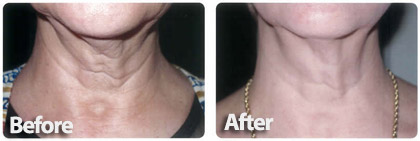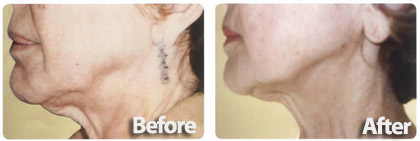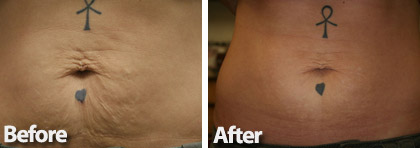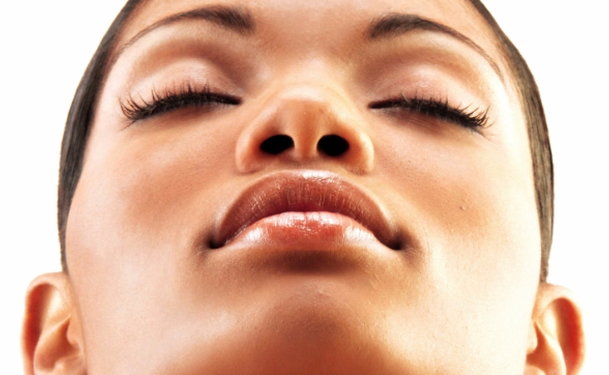What is Skin Tyte?
New advances in light energy have led to the development of a non-invasive treatment of skin laxity which is safer and more effective than ever before. Sciton ST Broad Band Light offers safe infrared light energy and advanced skin cooling technology to comfortably deliver heat below the skin's surface for increased tissue tightening and reduced skin laxity.
This ground-breaking new technology is used to selectively heat the dermal collagen deep in your skin while at the same time cooling the epidermis (outer layer of skin) prior-to, during, and after treatment, reducing pain and minimizing internal thermal injury to adjacent skin structures. The result is partial coagulation and contraction of collagen which tightens the skin.
What can Skin Tyte do for my skin?

Skin Tyte treatment results in a much younger looking skin. The treatment uses a series of pulsed infrared light to improve the appearance of sun damaged and aged skin, as well as decrease patches of facial and neck redness and flushing.
Skin Tyte Treatments were developed to consistently and predictably improve the visible appearance of the skin with no down time. Skin Tyte treatments may be used over any area of the body that is aged or sun damaged.
What conditions can Skin Tyte treatment be used for?
As a single mode of therapy, Skin Tyte is useful for treating:
- Erythema (red) skin
- Flushed skin patches
- Acne scarring
- Rosacea
- Fine facial lines and wrinkling
- Telangiectasia hyperpigmentation
- Lentigines
- Before or after a face or neck lift surgery
- Before or after laser resurfacing
- After chemical peeling
- After Botox injection for wrinkles
- After collagen injections for wrinkles
- In combination with micro dermabrasion
Which area of the body can be treated with Skin Tyte?
SkinTyte treatment is safe for all skin types and can be performed on any area of the body where an improvement in your skin firmness is desired. Popular areas include the face, neck, abdomen and arms.
How does the Skin Tyte work?
The SkinTyte process selectively photocoagulates soft tissue in combination with an integral thermo-electric cooler for use in cooling the epidermis at the treatment site prior to, during and after treatment to reduce pain and minimize heat injury to the adjacent skin structures.
By utilizing a broadband of light energy to heat dermal collagen, this process promotes the partial denaturation and contraction of collagen. The heat also stimulates the body's natural healing process which generates a renewed, firmer collagen base that leads to skin tightening.

How do I prepare for my Skin Tyte treatment?
Prior to your appointment, all facial make-up, ointments or creams must be removed. Men will be asked to shave on the day of treatment prior to arrival at the office.
For those with recent blisters on the face, the treatment may be delayed. Any recent facial infection, including herpetic sores may lead to a delay in the treatment. All skin infections and other lesions must be completely healed before Skin Tyte treatment can be done.
Prior to the procedure, eye shields/goggles will be placed around the eyes. For those who are very sensitive to pain, a soothing gel will be placed on the skin prior to treatment, which will help reduce discomfort.
How is the procedure done?
A Skin Tyte procedure is a series of gentle and safe pulsed infrared light energy treatments. The treatments are done with a specially equipped light beam. Most individuals requires 2-5 sessions. Each session is spaced at an interval of 3-4 weeks.
This treatment takes about 45 minutes per area, and is done in the office. The most commonly treated areas are the face, neck, and upper chest.
Do I feel pain during the procedure?
Most patients do not need any general or IV sedation, but a topical cream can be applied 30-60 minutes prior to the treatment eliminating most discomfort. For those with sensitive skin, every precaution is taken to prevent pain and relieve the anxiety.
How does one feel after a Skin Tyte Procedure?
There is minimal facial swelling the first day but one can wear make up soon afterwards. Optimal results from dermal remodeling are seen over a three to six month period. Most patients require an average of 3 treatments spaced one month apart. Because each patient's skin is different, the treatment number can vary. After the procedure you may be asked to ice the area and may be given additional post treatment instructions.
Who gets the best results from Skin Tyte?
Individuals with aging or irregular skin texture, and those who have skin pigmentation from excessive sun exposure see the best results. Skin Tyte has also helped patients who suffer from photo-aging of the skin, such as pigmentation from sun exposure (age spots) and irregularities of skin texture. Skin Tyte also helps to improve mild acne scars and reduces the pore size on the skin. The therapy can also reduce fine lines around the lips, mouth and eyes.
How many Skin Tyte treatments are needed?
After the initial series of 3-5 treatments most individuals may require follow up treatment in 2 or more years. To maintain the newer cosmetic look, advice will be given for future skin care.
When can one see the results after Skin Tyte?
The majority of patients feel that their skin is tighter after just one treatment, but visible improvements in skin laxity generally take place over three to six months.
Will Skin Tyte treatments help my acne scars?
Shallow scars from acne and fine lines will be improved, but long standing deep acne scarring cannot be helped with this treatment. Laser resurfacing may be needed for deep scarring.
Can Skin Tyte be done on the eyelids or lips?
Yes, however, the procedure does cause moderate amount of swelling and bruising of the eyes and most individuals are not able to go out without dark glasses. The lips are painful for a few days.
What are the advantages of Skin Tyte?
You can have glowing, smooth, blush-free skin with finer lines and more youthful looking skin with no need to take time off from work. You can usually go to work the same day or the following day. No procedure has ever been developed that can accomplish so much with such low risk and little down time.
When can I go out after Skin Tyte?
Recovery depends on the area treated. The most invasive treatments may produce enormous improvements, but may require an extended recovery time of multiple weeks. A gentler skin rejuvenation treatment may reduce the appearance of some imperfections and may require little or no downtime. The swelling and bruising usually takes two to four days to disappear.
Does Skin Tyte have side effects?
Most side effects are mild and of short duration. These can consist of short term discomfort during the actual treatment. There is usually additional redness immediately following treatment, lasting less than 24 hours in most people, on rare occasions it may last up to three days. Mild blistering and bruising is possible but occurs in less than 1% of patients and usually clears up very quickly.
Post treatment pigmentation has been noted on occasion, but is highly treatable and very rare. Even rarer is a decrease in pigmentation of the skin after treatments. This also clears in time as well. Scarring or infection of the skin after treatment is extremely rare, but it can occur. Swelling of the face for 3-5 days occasionally occurs and is most common in severely sun damaged skin due to reduced quality of connective tissue around the blood vessels.
How much improvement will I see?
Typically 75-95% improvement has been reported after a set of treatments. While results vary from patient to patient, there have been reports of 50% improvement in redness and Rosacea, and between 30-40% improvements in pigmentation. Current studies indicate 90% Skin Tyte Rejuvenation patients have a high degree of overall satisfaction with the results.
Will I need additional treatments?
After the initial series of 3-5 treatments, maintenance sessions are often needed. Proper caring for the skin will help diminish the likelihood of future treatments. Reports show patients return every six months for a follow-up treatment because they love the way the treatment improves their appearance.

Who should not have the procedure?
A Skin Tyte Rejuvenation is not recommended for patients with connective tissue disease or autoimmune disorders.
It is not advisable for pregnant women, nor is it safe for recently sun-tanned skin or in those who may receive excess sun exposure in the immediate weeks following treatment.
Those individuals who are taking Accutane should wait a minimum of 4-6 months before undergoing a Skin Tyte procedure. The procedure is also avoided in individuals who have an acute outbreak of acne, blisters or who have active Rosacea.
Most photosensitive medications such as antibiotics, anti anxiety, sulfa drugs, birth control pills and anti-hypertensive medications are not a concern. In patients who have blister sores (herpes) on the face, an anti-herpes medication should be taken prior to treatment.
What are the skin conditions not likely to be helped by Skin Tyte Rejuvenation?
It will not improve the appearance of frown lines, which are the lines of expression on the face, especially the forehead and between the brows. It will not help baggy or sagging skin, puffiness around the eyes, or skin cancer. Skin Tyte Rejuvenations have shown to treat pre-cancerous lesions known as "actinic keratosis." It won't remove bumpy moles, but a Skin Tyte Rejuvenation treatment might remove their pigment. Genetic freckles usually return after treatment.
Can the same results be achieved with chemical peels or micro dermabrasion?
No, although Skin Tyte treatments are often used in alternate sessions with certain types of peels and microdermabrasion. The combined use of Skin Tyte Rejuvenation with microdermabrasion has been shown to enhance the benefit of this procedure by reducing the dilated capillaries and redness that microdermabrasion is unable to help.
Who Is Not a Good Candidate For Skin Tyte Rejuvenation?
For those who are prone to keloids, hyper or hypo pigmentation, are dark-skinned, darkly tanned or do not react well to burns, Skin Tyte is not a good option. The results are excellent for those with brown skin tone.
If you are an insulin-dependent diabetic, you can not be treated.
You are also not a candidate if you have a blood clot-forming disorder (i.e. excessive bleeding).
What should be avoided prior to a Skin Tyte Treatment?
You should discontinue the use of any blood thinners such as Coumadin, Heparin, aspirin or other types of anti-platelet or anti-coagulant herbal remedies including garlic, ginger, cayenne, papaya and bilberry tablets/supplements.
How much does the treatment cost?
The cost is variable and depends on the area requiring treatment. On average, the costs start at around $300 and can be as high as $1000 per session.
Is the cost covered by insurance?
The Skin Tyte rejuvenation procedure is strictly cosmetic and not covered by any medical insurance company or Medicare.


